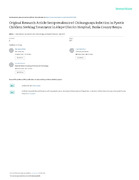| dc.description.abstract | Chikungunya fever is a viral disease transmitted to humans majorly by a bite of
infected Aedes aegypti mosquitoes. Studies have revealed that other species of
Aedes mosquitoes equally transmit chikungunya virus (CHIKV). This study was
conducted to determine the prevalence of CHIKV in febrile children seeking
treatment in Alupe District Hospital, Busia Kenya. This was a hospital based cross- sectional study of 384 febrile children aged 1 to 12 years. A detailed clinical history
and socio-demographic information of the study participants was taken by the
clinician after signing a consent form. Whole blood of about 5 ml was collected in
vacutainers, centrifuged to obtain serum for antibody detection. Enzyme-linked
Immunosorbent Assay (ELISA) and Plaque Reduction Neutralisation Test (PRNT)
tests were performed to detect the chikungunya antibodies. The median
(Interquartile range) age (months) for the febrile children was 54 (30, 96) and
majority 55.5% (213) were female. More than three quarters 76 .8% (295) were
rural dwellers and 55% (211) attended school. Majority of the children 72.1% (277)
were under the care of their mothers. The prevalence of CHIKV was 9.4% (36) and
11.5% (44) using ELISA and PRNT techniques, respectively. The wet month of
September had the highest prevalence (40.9%) and febrile children from the rural
areas were the most affected{79.5% (35/44)}. In the study population, the common
symptoms and signs exhibited were malaise (33.1%), nausea (23.4%), stomachache
(214%), headache (19.3%) and fever (100%), rash (40.6%) respectively. It is
therefore recommended that if a patient is diagnosed with typhoid or other more
prevalent infectious diseases, CHIKV should be tested for. Serology and molecular
diagnosis should be used simultaneously for better case detection. | en_US |

